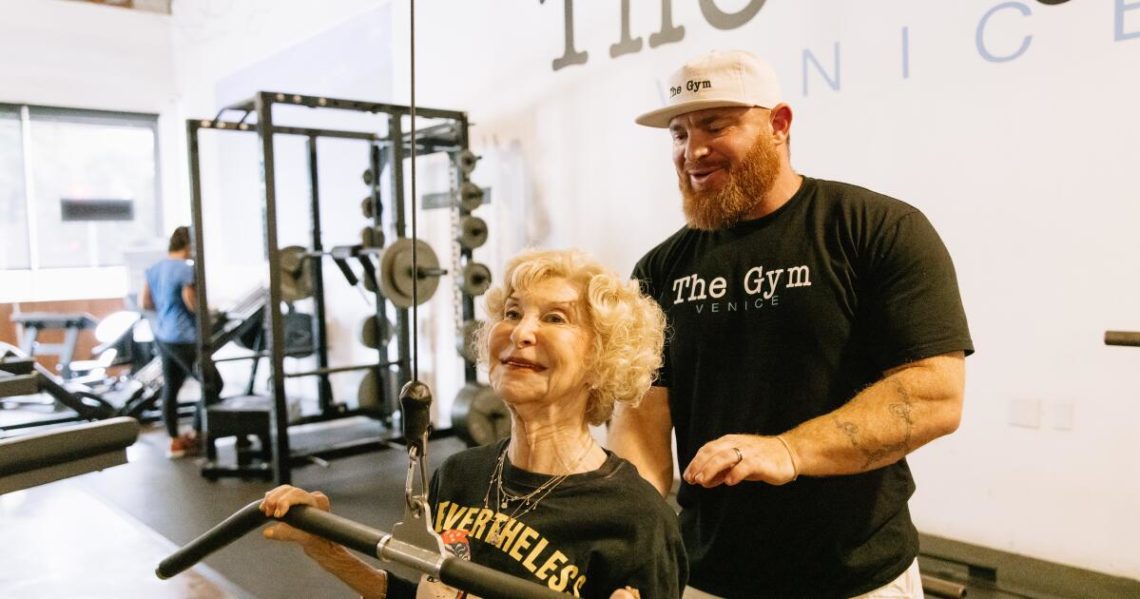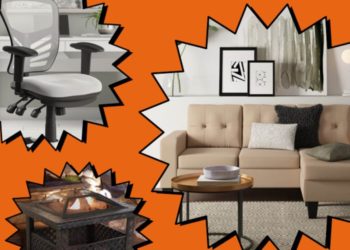The sidewalk sign outside of the Gym Venice was promising: “Your 40+ Comeback Starts Here.”
“Well, how about an 80s-plus comeback,” my mom quipped, as we headed inside.
She’d just turned 83 a few days earlier and was visiting L.A. from the East Coast. She’s a retired, but still feisty, judge who now works as a mediator. And while she wasn’t much of an exerciser when I was growing up in Philadelphia, she now considers herself a “geriatric jock.”
“I do Silver Sneakers on Zoom almost every day,” she boasted of her online fitness routine. “Let’s see what they have to show me here.”
Turns out, a lot.
The Gym Venice specializes in training bodies over 40-years-old, which have different needs, when it comes to strength training, than younger exercisers, says owner Kris Herbert. For starters, older bodies — especially after years of a sedentary lifestyle — are more susceptible to injuries. Conditions such as osteoporosis and arthritis can lead to weakened muscles, fragile bones and unstable joints as well as balance issues.
Herbert’s gym isn’t the only locale training adults in midlife and beyond. Still Got It Fitness, in Lomita, and Q4 Active, in Woodland Hills, both train exercisers over 50.
The niche approach is for good reason. As we age, we also lose muscle mass — as much as 3% to 5% per decade after age 30, according to the National Institutes of Health — and our metabolism slows, which can lead to weight gain. When strength training later in life, more attention must be paid to building strength around the joints, Herbert says, and strengthening the posterior, or back, chain of the body.
“For the most part, the clientele here has very sedentary jobs sitting at desks and they [can] get tech neck and their back and posture can get compromised, causing lower back pain,” he says. “So here, it’s all about building skeletal muscle mass — which helps with metabolism, bone density, regulating hormones, everything — and getting your back and posture strong so you can support yourself.”
“Cool. I’m in!” my mom said. She was wearing her favorite T-shirt, picturing Rosie the Riveter and the text “Nevertheless, she persisted.” “Where do we start?”
The former guitar shop on Venice Boulevard — with its bow truss ceiling, exposed wood beams and a polished concrete floor — limits attendance to five clients and their trainers at any given time, so that the environment is calm and visitors can better focus on their workouts — no big-box gym sound system blasting hip-hop, just background chit-chat and the occasional sound of clanking metal from barbells. 95% of the gym’s clientele is between the ages of 40 and 65, with a few clients in their 70s and 80s and several teenagers who come in to work out with their parents. The gym’s trainers — there are seven on staff — are mentored by Herbert, 42, and gym manager Ed Gemdjian, 45. They’re taught how to train older bodies and modify movements when clients have limitations. Then they shadow other trainers before working one-on-one with clients. Gemdjian also holds weekly workshops on various aspects of training older adults.
“They have to have an understanding of our specialized equipment,” Herbert says of his trainers, “as well as how to meet clients where they are — which could mean limited mobility or joint issues — to safely and properly put them through a workout.”
As Herbert explained all this, my mom nodded enthusiastically. She has both osteoporosis and arthritis and is concerned about her bone density. She’s also had two hip replacements. But after Herbert’s explanation of how his trainers work with clients, she felt she was in good hands.
“He seems to know his stuff,” she said, “especially about issues that women face as they age.”
Our mother-daughter session began as any new member’s would: with a full body assessment followed by mobility and ability tests so that Herbert could design a customized training program for each of us. He had us step on a body composition scanner, which looked like a slender scale. After wiping off our palms and soles (to increase conductivity), we stepped onto it and waited about a minute. Then it printed out a sheet of charts and graphs. It gave us a detailed muscle-fat analysis, including our total skeletal muscle mass in pounds, our basal metabolic rate (the number of calories we burn at rest), our overall body fat percentage as well as a “segmental fat analysis” that broke down our fat percentage across each arm, leg and on our trunk. Most importantly, it showed our visceral fat level, which means the fat around our organs.
“That is huge for disease prevention,” Herbert says. “We’re trying to keep that low.”
The body assessment was intimidating at first — I mean, who really wants to know the exact percentage of fat on their belly? But my mom found the information empowering.
“So, like, you’d design a special program especially for me?” she said, almost teary-eyed. (I explained that all trainers do that, whether the client is over 40 or not. But still, she was impressed with Herbert and sang the gym’s praises as we moved into the next testing phase.)
“If I lived here, I could track my progress on the body scanner week to week,” she said, trailing behind Herbert. “I love that!” (Mom’s enthusiastic.)
The mobility test included our laying on a floor mat while Herbert guided us in doing three lower extremity stretches — a spinal twist, for example — followed by three upper body stretches, such as a shoulder raise, with light bands.
After that we did the ability test, gauging how we performed different compound movements — meaning multi-joint movements using major muscle groups — on machines or with hand-held weights, cables or bars.
“We want to make sure our clients can do the movements with full range of motion, pain-free,” Herbert says. “That’s how we can test what you can and cannot do at the gym, so that we can create a program for you. Then we bullet proof your back — make you strong for everyday things, like carrying groceries.”
Mom was down: “Count me in,” she said (a favorite phrase), while checking out her form — and her freshly highlighted hair — in the mirror as she did a bicep curl with a 5-pound weight.
The gym also features special equipment that caters to older bodies. Many of the weight machines are designed to be lower impact, for example, and therefore kinder on the joints. The bench pad used is 4 inches wider than a standard bench pad, eliminating shoulder overhang and protecting the chest and shoulders. They also use “specialty bars” to avoid impact on the shoulders. “So you can push yourself safely, harder,” Herbert says.
He walked us over to a hunk of metal glistening by the window. It looked like a medieval torture device … or something you’d see at San Diego Comic-Con.
“It’s a belt squat machine,” Herbert explained, slipping the padded belt around his waist. “It’s for people with shoulder impingement or spinal compression issues. It takes all the compression off your spine and allows you to perform a squat under resistance.”
Then he pointed to another piece of equipment. “That’s a bilateral leg press,” he said. “You can work one leg at a time if you have imbalances.”
Mom watched, eyes wide with possibility, as if Herbert were showing her a swanky vacation timeshare in Maui.
“I could do that,” she said. “This place, for someone like me — I have two bionic hips, you know — it feels like a safe space to try something and initially fail, but then with hard work and encouragement eventually be able to do it.”
Despite her enthusiasm, I doubted my mom would join the Gym Venice if she lived in Los Angeles. The gym does offer a $99 weeklong trial that includes a body composition scan, mobility-ability tests and three personal training sessions. But the per-session rate after that ranges from $140 to $175 — which is steep by anyone’s measure.
I was surprised, however, when I asked my mom about it later.
“I’d do it because I’m still working,” she said. “It’s expensive, but you make choices and what better choice to make than to try and improve your health and extend your longevity.”
I conveyed that to Herbert on the phone.
“That’s what gives this meaning for me,” he added. “I’m excited to help everybody age gracefully, to help people regain control. The years pass, we all grow older; but we don’t have to get old.”
The post This L.A. gym claims it’s for people over 40. Here’s what my 83-year-old mom thought of it appeared first on Los Angeles Times.




